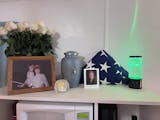by John M. Stuart, MSW

How does it feel to live in a home where a loved one passed away? In-home hospice care allows death to occur naturally at home. It is not uncommon for families to be faced with this situation and the related emotions.
When death in the home is a positive experience
Being at the bedside of a loved one when his last breath is taken can be as powerful as witnessing a birth. Those in the dying process often express a wish not to be left alone in a hospital or nursing facility, but to be surrounded by family and friends.
The following story illustrates how the room where a loved one has died can be a special space that provides spiritual comfort to those experiencing loss.
The room where Jack "moved on"
JoAnn and Jack Rushton raised seven children. Their lives were suddenly turned upside down when Jack was involved in an accident at Laguna Beach, California. After intensive rehabilitation, Jack was paralyzed from the neck down. He was dependent on a respirator for every breath.
Jack was an example to many. He lived each day with courage and hope. He demonstrated how physical limitations were not a hindrance to one's spiritual and emotional well being. Jack lived 20 years after his accident - 15 years longer than expected. After many close calls with death, he found that every moment he spent with family and friends was precious.
Jack spent Christmas Eve singing carols with children and grandchildren. He then gave each one a special book that he compiled. He told his family that the book, his life story, was the last project he needed to finish before moving on. That night he went to bed and "moved on" from his physical existence. His lifeless body lay peacefully in bed as his family sang comforting spiritual hymns, and said goodbye.
JoAnn keeps the room where Jack "moved on" exactly the same. Jack’s books still fill his personal library while family pictures and keepsakes accessorize the room with cherished memories. The space where Jack died brings comfort to the Rushton family. JoAnn plans to stay in "their" home of 40 years, making certain not one memory of their life together is lost.
When death in the home is a negative experience
What about those who don't want the memory of someone dying at home? Seeing someone take a final breath can leave strong emotional impressions, especially when it occurs at home.
Some believe a negative energy lingers where someone died. Displaying a cremation urn in the home or wearing urn jewelry can trigger similar feelings. More positive feelings may come from scattering the cremains from an ash urn or burying a biodegradable urn in the soil to breakdown in the elements.
Beginning the healing process
The following suggestions can be helpful in letting go of discomforting feelings when someone dies at home:
- Redecorate or reposition furniture in the room where someone died.
- Get rid of clothes belonging to the deceased. Donating clothes and other belongings to a charity can be comforting.
- Introduce new and healing smells into the environment with aromatherapy. This can release sad or painful associations.
- Do a cleansing ritual. A common Native American tradition is to burn sage (smudging) to rid surroundings of negative energy.
It's important to remember that not wanting a loved one to die at home is as common as accepting when a loved one dies at home. Each individual’s response to the situation will carry its own unique resonance.
John Michael Stuart, MSW has been a social worker since 1997. He has worked in nursing home, hospice and home health settings, including one of the nation's largest Social HMO demonstration projects where he coordinated care between physicians, patients and their families. John has had cerebral palsy since birth and has authored Perfect Circles, Redefining Perfection. He is also a public speaker and currently works as a home health social worker in Las Vegas.

